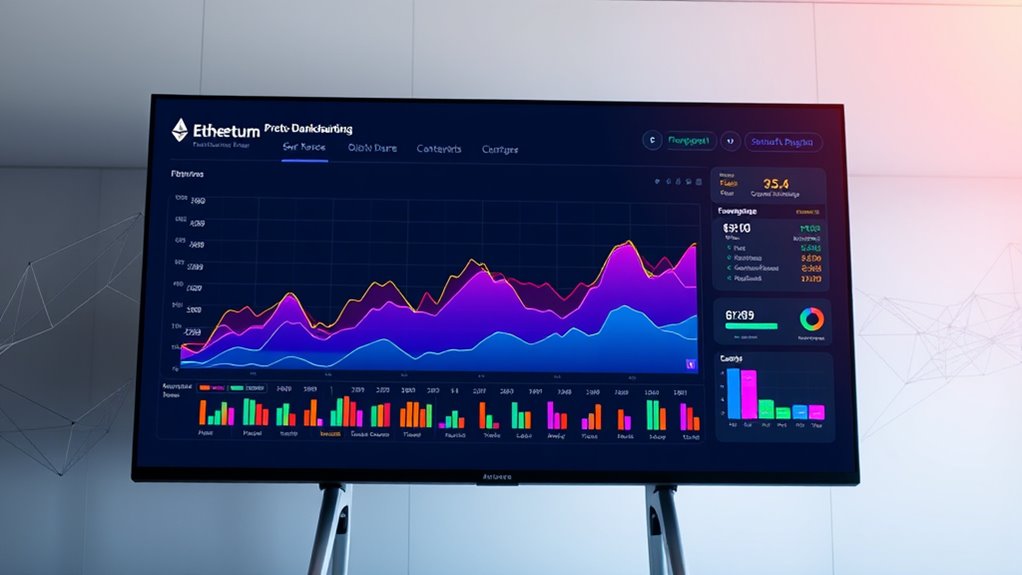The Ethereum proto-danksharding upgrade improves network capacity, which leads to more stable and lower transaction fees during busy times. The fee charts show a clear decrease in average costs, especially during peak demand, making transactions more predictable and less expensive. This upgrade helps prevent costly spikes and enhances user experience overall. If you want to uncover how these changes are shaping Ethereum’s future, there’s more to explore below.
Key Takeaways
- Fee charts show a significant decrease in average transaction fees during peak periods after the upgrade.
- Sharding increases network capacity, reducing congestion and stabilizing fee volatility.
- The upgrade leads to more predictable and manageable transaction costs for users.
- Lower fees during high demand improve accessibility for small and frequent transactions.
- Overall, fee trends indicate improved network scalability and a smoother user experience.

Ethereum’s Proto-Danksharding upgrade marks a significant step toward scaling the network more efficiently. As you’ve likely noticed, one of the biggest hurdles for Ethereum has been scalability challenges. These challenges manifest in slow transaction times during peak periods and skyrocketing transaction fees, which can make using the network costly and frustrating. The upgrade aims to address these issues by introducing data sharding, which helps spread transaction load across multiple data chunks, reducing congestion. This change is designed to improve overall throughput, meaning you’ll experience faster transactions and lower fees, especially when the network is busy.
When you look at fee charts before and after the upgrade, you’ll see a noticeable difference. Historically, during high demand, transaction fees—measured in gwei—have spiked dramatically, sometimes making small transactions uneconomical. The Proto-Danksharding upgrade targets precisely these spikes by enabling the network to process more data simultaneously without overloading. This means that during periods of high activity, fees will be less volatile, giving you a steadier experience and reducing the cost barrier for everyday users. The upgrade doesn’t eliminate fees altogether but makes them more predictable and manageable, which is a big win for users like you who want to avoid paying exorbitant costs.
Proto-Danksharding reduces fee spikes, making Ethereum transactions more stable and affordable during high demand.
As you follow the fee trends over time, you’ll notice that post-upgrade charts show a decrease in average transaction fees during peak times. This is a direct result of the increased capacity that Proto-Danksharding provides. It’s not just about speeding up transactions; it’s about making the network more accessible. Lower fees mean you can send small transactions, participate in decentralized finance (DeFi), or interact with smart contracts without worrying about paying a fortune. Furthermore, these changes improve user experience by reducing network congestion, allowing you to execute transactions more reliably and with less delay. Additionally, understanding the underlying risk management strategies involved helps you make informed decisions about transaction timing and costs.
While the upgrade is still in its early phases, the initial fee charts suggest a positive trajectory. As more data is processed with the new sharding method, the network’s ability to handle increased load becomes clearer. You can expect that, over time, Ethereum will become less prone to fee spikes, making it more practical for everyday use. In essence, the Proto-Danksharding upgrade is a vital step toward solving Ethereum’s scalability challenges, helping you save money and enjoy smoother, more predictable transactions on the network.
Frequently Asked Questions
How Will Danksharding Impact Overall Ethereum Network Security?
Danksharding will enhance Ethereum’s sharding security by distributing transaction validation across multiple shards, making attacks more difficult. This upgrade promotes fee stability by optimizing data availability, leading to more predictable costs for users. As a result, you’ll experience a more secure network with consistent fees, encouraging broader participation. Overall, danksharding strengthens Ethereum’s resilience while maintaining fee stability, ensuring a safer and more reliable environment for your transactions and applications.
What Are the Potential Risks of Implementing Proto-Danksharding?
You should consider that implementing proto-danksharding may introduce risks like network congestion, which could slow transaction speeds and increase fees. Additionally, smart contract risks could arise if the upgrade isn’t properly tested, potentially leading to vulnerabilities or exploits. While the upgrade aims to improve scalability, you need to stay aware of these potential issues to make certain your assets and activities remain secure and efficient.
How Might Fee Dynamics Change Post-Upgrade?
You might notice fee dynamics shift after the upgrade, with fee elasticity increasing due to improved scalability. This means transaction costs could become more predictable, making user affordability better maintained during high demand periods. As the network handles more transactions efficiently, you may experience lower or more stable fees, encouraging more activity. Overall, the upgrade aims to balance network load with reasonable fees, benefiting you as a user by providing a more consistent experience.
Will Smaller Users Benefit From the Upgrade’S Fee Structure?
You might find that smaller users benefit from the upgrade’s fee structure because it aims to improve fee affordability and user access. By reducing transaction costs, the upgrade makes it easier for you to participate without worrying about high fees. This encourages more people like you to use Ethereum’s network, ensuring broader access and potentially increasing your ability to engage with decentralized applications and services more affordably.
How Does This Upgrade Compare to Previous Ethereum Scalability Solutions?
You’ll find this upgrade differs from previous Ethereum scalability solutions because it aims to improve layer 2 scaling while maintaining decentralization. Unlike earlier methods that often sacrificed decentralization for higher throughput, proto-danksharding balances both by enabling more efficient data availability. This reduces fees and congestion, benefiting smaller users without compromising network security. Overall, it’s a more sustainable approach, ensuring Ethereum remains decentralized while scaling effectively.
Conclusion
Ultimately, the fee charts show that Ethereum’s proto-danksharding upgrade could considerably reduce transaction costs, making the network more affordable and accessible. As you watch these developments, you’ll notice how this upgrade boosts scalability and efficiency, encouraging more users and developers to participate. While challenges remain, this upgrade marks a promising step toward a faster, cheaper Ethereum, paving the way for broader adoption and innovation in the blockchain space.








